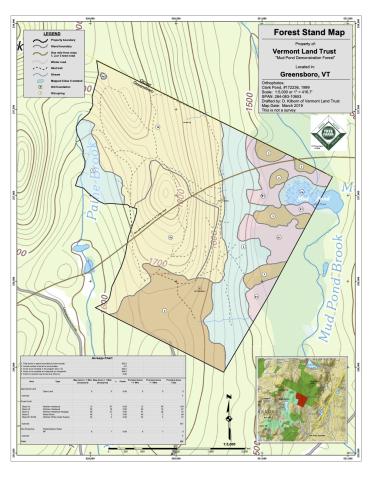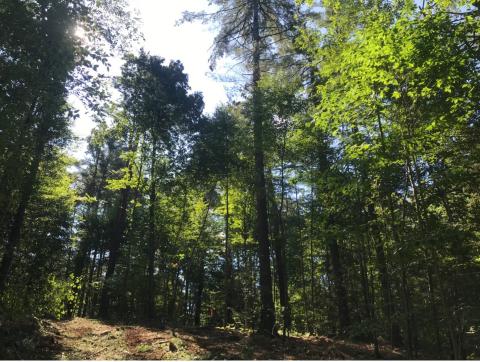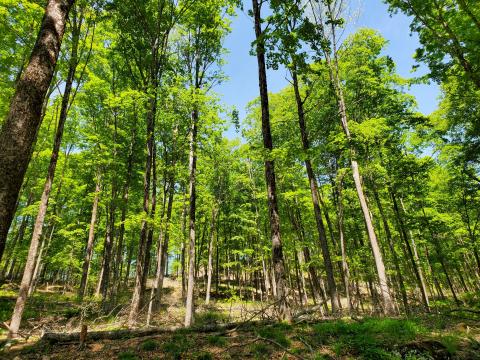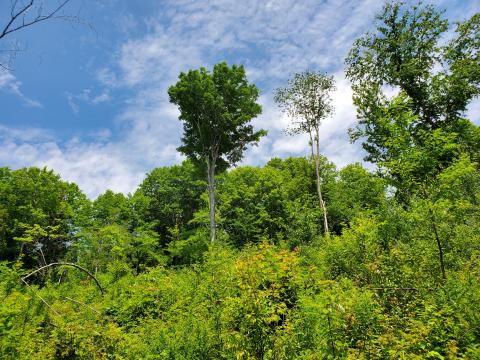Explore Case Studies by Location
Explore Case Studies

|
Mud Pond ForestDescription: Mud Pond Forest is a 362-acre parcel that is dominated by northern hardwood forest with sections of northern white cedar swamp, intermediate fern, and northern hardwood seepage forest. This silvicultural treatment is on a 175-acre northern hardwood, rich northern hardwood natural community-dominated stand that is about 80-years old. There is currently minimal forest health concerns, but the arrival of Emerald Ash Borer will impact the ash resource on the property. This project strives to demonstrate how activate forest management can facilitate positive stewardship outcomes. The three focus areas occurring on tis site include: silviculture for climate change, managing for quality forest bird habitat, and management of ash in a pre-EAB infestation. State/Province: Vermont Forest Type: Northern Hardwoods Citation: Dan Kilborn, , Mud Pond Forest, Northeast Silviculture Library, University of Vermont. Accessed 12/09/2025 at https://www.uvm.edu/nesl/webform/new_case_study/submissions/53. |
|
|
Pharsalia Woods State ForestDescription: The forest at this site was an over-mature black cherry, red maple, and sugar maple forest, with poor health and high mortality in the sugar maple from past defoliation. In the past, traditional single tree and group selection harvesting would have been used to harvest a stand like this, but this method has not been successful at creating new desirable regeneration in this region due to deer browse and abundant interfering vegetation, such as beech and fern. Instead, the goals of this project were to use small patch clearcuts, 1-3 acres in size to try to establish a new generation of seedlings and saplings. State/Province: New York Forest Type: Northern Hardwoods Citation: Christopher Sprague, , Pharsalia Woods State Forest, Northeast Silviculture Library, University of Vermont. Accessed 12/09/2025 at https://www.uvm.edu/nesl/webform/new_case_study/submissions/54. |

|
Meadowsend Timberland Ltd. NH7 – Governors Island ForestDescription: The property is located in Hampstead, NH and is Meadowsend most-southern property. The land has been owned by Meadowsend for over 30 years and two harvest treatments have been applied prior to initiating the latest harvest entry. Past harvesting has been focused on promoting the best quality pine while promoting the regeneration of a new cohort. Past management successfully regenerated a second cohort which is dominated by hardwoods. The most recent harvest was conducted in the fall of 2023 during an abundant white pine seed year. State/Province: New Hampshire Forest Type: White pine - hemlock - transition hardwood Citation: Meadowsend Timberland Ltd., 2023, Meadowsend Timberland Ltd. NH7 – Governors Island Forest , Northeast Silviculture Library, University of Vermont. Accessed 12/09/2025 at https://www.uvm.edu/nesl/webform/new_case_study/submissions/55. |

|
Adaptive Silviculture for Emerald Ash Borer (Corinth, Vermont)Description: Test co-produced adaptive silvicultural systems for increasing the resilience of rich northern hardwood forests to the impacts of emerald ash borer invasion and climate change. State/Province: Vermont Forest Type: Northern Hardwoods Citation: Tony D'Amato, 2023, Adaptive Silviculture for Emerald Ash Borer (Corinth, Vermont), Northeast Silviculture Library, University of Vermont. Accessed 12/09/2025 at https://www.uvm.edu/nesl/webform/new_case_study/submissions/56. |

|
Adaptive Silviculture for Climate Change (Second College Grant, New Hampshire)Description: Test silvicultural systems that adapt northern hardwood forests to anticipated changes in climate and disturbance regimes. State/Province: New Hampshire Forest Type: Northern Hardwoods Citation: Anthony D'Amato, 2021, Adaptive Silviculture for Climate Change (Second College Grant, New Hampshire), Northeast Silviculture Library, University of Vermont. Accessed 12/09/2025 at https://www.uvm.edu/nesl/webform/new_case_study/submissions/57. |

|
Myles Standish Complex Pine Barrens RestorationDescription: MassWildlife and the Department of Conservation and Recreation are restoring over 2,500 acres of pitch pine and scrub oak barrens. These barrens habitats are naturally sandy and fire prone. The principal objectives of this project are to restore an open canopy pitch pine – scrub oak community to benefit state-listed butterflies & moths, native songbirds, game birds, and to mitigate the wildfire hazard associated with the current heavy fuel load conditions. State/Province: Massachusetts Forest Type: Pitch pine – scrub oak Citation: Paul Gregory & Fletcher Clark, 2028, Myles Standish Complex Pine Barrens Restoration, Northeast Silviculture Library, University of Vermont. Accessed 12/09/2025 at https://www.uvm.edu/nesl/webform/new_case_study/submissions/61. |

|
Tunk Hill Experimental Climate Adaptation PlantingDescription: Providence Water implemented an experimental "transition" climate adaptation planting seeking to improve regeneration in an area of forest surrounding the state's main reservoir. Seedlings both native and novel tree species projected to be adapted to future climate conditions were planted in an area that experienced oak regeneration failure. Half of the seedlings of each species were planted within a deer exclosure fence and half were planted in an unfenced area nearby. Annual monitoring has allowed for comparison of survival and growth of the planted trees at these two sites since 2015. The difference in tree survival rates between the fenced and unfenced sites is largely attributed to deer herbivory. State/Province: Rhode Island Forest Type: Mixedwoods Citation: Christopher Riely, 2015, Tunk Hill Experimental Climate Adaptation Planting, Northeast Silviculture Library, University of Vermont. Accessed 12/09/2025 at https://www.uvm.edu/nesl/webform/new_case_study/submissions/63. |

|
Peru Town Forest – "Seed-Tree" Treatment to Favor White Ash RegenerationDescription: The goal of this treatment was to create conditions favorable for the regeneration of white ash in a stand with a higher risk of infestation from the emerald ash borer (EAB) in the near future due to proximity to a confirmed infestation and where overstory white ash are already exhibiting symptoms of decline due to a causal agent other than EAB. A “seed-tree” treatment was implemented on approximately 8 acres where all stems down to 2” DBH were removed excepting those trees selected as “Leave Trees.” White ash in dominant canopy positions in the pre-treatment overstory and exhibiting good vigor / lack of symptoms of decline, were selected as “Leave Trees” at an average rate of 10 stems per acre. Of those trees selected for retention, female trees were prioritized. State/Province: Vermont Forest Type: Northern Hardwoods Citation: Cory Creagan, , Peru Town Forest – "Seed-Tree" Treatment to Favor White Ash Regeneration, Northeast Silviculture Library, University of Vermont. Accessed 12/09/2025 at https://www.uvm.edu/nesl/webform/new_case_study/submissions/64. |

|
Brasher State Forest, The Nexus between Forest Research and Partnerships for SuccessDescription: The Brasher State Forest has been a focal point for collaborative forest resource management between the Akwesasne Mohawk community, Academic, State, and Federal partners. Since the early 1990's, the site has provided opportunities for research on black ash, silvicultural practices, and shared resource management including direct input in to the New York State forest management plans. Over 3 decades, the span of multiple careers the partnerships have generated a wealth of information about black ash and now Emerald Ash Borer management. The contributions of each partner has increased the knowledge about ash management, tribal cultural practices, forest pest management, and has been a model for success. State/Province: New York Forest Type: Northern Hardwoods Citation: Les Benedict, , Brasher State Forest, The Nexus between Forest Research and Partnerships for Success, Northeast Silviculture Library, University of Vermont. Accessed 12/09/2025 at https://www.uvm.edu/nesl/webform/new_case_study/submissions/65. |

|
Tannery Road Timber SaleDescription: Implement silvicultural systems that improve forest resilience through resistance and resilience adaptation practices. State/Province: Massachusetts Forest Type: Northern Hardwoods Citation: Kevin Podkowka, 2019, Tannery Road Timber Sale, Northeast Silviculture Library, University of Vermont. Accessed 12/09/2025 at https://www.uvm.edu/nesl/webform/new_case_study/submissions/69. |